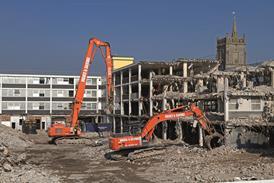Can we liken this scenario to social housing? To many housing associations the analogy is a little too close for comfort. The existing relationship isn't really going anywhere. The good old days have gone. But the other option - the new start with a new set of rules, new friends and activities - is scary. To try to have it all could mean becoming "jack of all trades - master of none" and might end in ruin - or would it? Challenges and opportunities or threats and uncertainties? Let's look at the facts.
The current picture for social housing isn't good. Of course, there are some notable exceptions (and the London / southeast picture is another story). But on the whole, this tenure is not exactly in vogue. Although it is true that low demand often gets confused with unpopular housing, whatever the cause, the effect is still the same. We are manufacturing a product that not many people want. So why are we still doing it?
If we were running the social housing business in a market-orientated or commercial fashion, we would undoubtedly take a different approach. Few manufacturers/suppliers in a commercial world, be they for washing powder or chocolate bars, would take such risks with their corporate reputation, or their products, let alone their investment.
Planning and change management guru Arie P de Geus tells us that in the commercial world "successful change grows out of a company's knowledge of itself and its environment. The ability to learn fast (and faster than your competitors), is the key to survival and success."
Do we in housing associations really know our objectives, know our environment, understand our market? Do we carry out genuine market research? As a result do we constantly hone and refine our product to make it more and more attractive and desirable to new customers and to keep existing customers for longer? Are we constantly looking to have the edge over competition (other tenures)? Sadly, the answer to many of these questions is "no".
Since the early 1990s, surveys have shown that not only do most existing tenants see social housing as temporary, but potential tenants, especially young people, simply do not see social housing as an option. If it figures at all, it is often seen as a final resort, when all else fails. To a business planner such evidence coupled with low demand, should have long ago signalled a need for product enhancement, adjustment or replacement.
Our "market" has traditionally been one with no option but to buy our product. This coupled with the fact that we have received relatively generous government subsidy to supply our product has lead to an unacceptable level of complacency. To milk the commercial analogy, we are making Mars bars for a market who have told us that, although they liked them in the past, times - and tastes - have changed and they now prefer Snickers. We are resisting this change in appetite.
Because we know most of them haven't got a choice, we are ignoring clear indications of customer preference. But the worm, as they say, is turning. Many of our existing and potential customers, are now prepared to go hungry - to do without.
This is all dangerous ground at a time when government spending in all areas is being questioned in terms of its value for money. To the government and to the electorate, education and health are the key priorities. The same can't be said of housing. Given the current facts and trends, and the seeming inability of the providers to respond, it might become increasingly difficult to defend even the current level of subsidy to social housing in future years.
In their menopausal state, what would be the right life decision for housing associations to take?
The clever ones have already made the decision. They are embracing a new agenda, highlighted by the government's Social Exclusion Unit, and Lord Roger's report Towards an urban renaissance, which calls for urban/housing regeneration companies, to "co-ordinate and deliver area regeneration projects".
These associations becoming learning organisations whose strength is in strategic planning and enabling, whose ability is in forming strategic alliances in social and commercial endeavours.
Some are already involved in joint venture companies - perhaps the fledgling urban/housing regeneration companies that Rogers envisages. The clever ones recognise that theirs needn't always be the leading role but that they will bring in the skills and expertise where necessary to meet neighbourhood regeneration objectives and bow out when other partners can do it better.
These smart alecs of the housing world are critically examining the usefulness of their existing stock from a community and business perspective (the two objectives are rarely mutually exclusive).
Some are rationalising in areas where terminal decline has set in and no amount of subsidy or good intentions will revive the area from a housing perspective. Many are considering commercial use of the land and selling on to other organisations. They are looking hard to find ways to break up their existing large social housing estates. Some are selectively selling voids on the open market in order to introduce a mix of tenures.
They are no longer developing on a "Martini" basis - any time, any place, anywhere - just to keep cosy with the local authorities and to grow, grow, grow. They understand the needs of their existing market and the expectations of their potential market. They understand the intangibles like stigma. They are concentrating their efforts mainly in carefully selected sites around the country - where there is clear demand for their product. They are providing a new product range that is easily enhanced and updated - flexible housing - and that which would appeal to any tenure. They are mixing tenures and developing mixed use sites with strong community strategies, asset protection strategies and strong local partnerships.
These organisations are flirting outrageously, if not having fully fledged affairs with the private rented sector. City centre living is fashionable once more. Many associations have traditional expertise in brownfield sites and in rehab. With the possibility of reduced, or no VAT on rehab, cost-rent warehouse conversions to loft apartments and the like or even market rent to subsidise the low cost development next door - is good business if skilfully undertaken.
Affordable (state subsidised) housing will henceforth be under 50 per cent of their business.
Some will become specialists in a small number of areas and some will become large multi-faceted organisations providing wide-ranging regeneration services, home ownership, cost rented housing, market rented housing as well as the occasional commercial development (where it fits other objectives). They have asset protection, resident service and community strategies in place for non capital costs - not only for standard management and maintenance of stock but for things like neighbourhood caretaking, community and youth work, community buildings, environmental maintenance and facilities management.
What about those who are not such smart alecs? In times of turmoil and uncertainty, some will choose the "better the devil you know" option. They will hope that by ignoring evidence of a change in consumer preference, by working overtime to prop up the failing business - they will avoid the need to make hard choices and even harder changes. They will continually blame external forces for their problems instead of analysing and responding to them. They will see the solution only in terms of making requests for additional subsidies to deal with problems rather that re-orientating their business and their products to adapt to the changing environment. Of course, they may well survive, provided they have stock in the right areas (and where there is little competition for their market) and can keep the sparks clear from the powder keg on their existing estates.
At the other end of the scale, there will be a few romantic fools who fling themselves at the brave new world with no strategic plan or direction, with fewer resources, very little thought and a megalomaniac chief executive and/or board. It is highly likely that they will make a complete mess of things and end up, like our sad menopausal friend, broke and alone. We have already begun to see a few such casualties.
Unlike our sad friend, many probably can choose to have it all in a new life. A rekindled, exciting, existing relationship, new and exciting friends and new toys and gadgets. But only the smartest of smart Alecs who plan and strategize, who have and use-all the necessary information to hand, who understand and respond to their market, and yet have their feet firmly rooted on the ground, will be successful.
Source
Housing Today
Postscript
Julie Cowans is policy manager at Joseph Rowntree Foundation




















No comments yet